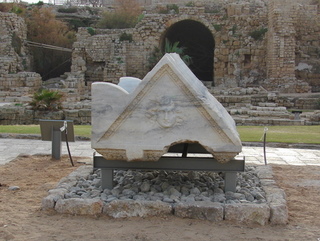A unique archaeological exhibition has opened in Caesarea harbor: for the first time the general public can see an extraordinary 1,700 year old sarcophagus cover that is one of the most impressive ever discovered in Caesarea.

The cover, which weighs more than 4 tons, is decorated with snake-haired medusa heads and joyful and sad-faced masks. These were taken from the world of the ancient theater where two kinds of plays were customarily presented: comedy and tragedy. The meaning of the Greek word medusa is “guard or sentry”; whoever looked directly at the mythological medusa would be turned to stone immediately. In antiquity they used to produce medusa reliefs on, among other things, tombs and various shields, in the hope that this would ward off the threat.
Interment in large stone coffins (sarcophagi) was widespread in the Mediterranean basin in the second to fifth centuries CE. This funerary custom was first practiced among pagans and was later also adopted by Jews, Christians and Samaritans. The word sarcophagus is Greek in origin, meaning “flesh-eating”. The sarcophagus has two parts: a rectangular chest-like receptacle in which the deceased was placed and a lid. The sarcophagi were interred inside burial structures (mausoleum; pl. mausolea) or in rock-hewn burial caves. The residents of ancient Caesarea were buried in cemeteries that were located in regions outside the built-up area of the city.
The impressive sarcophagus cover, which was probably used in the burial of one of Caesarea’s wealthiest denizens in the Roman period, is one of an assortment of unique stone items that were exposed in archaeological excavations and by other means in Caesarea. The items constitute living and tangible evidence of the lives of the rich in Caesarea, at a time when the city was a vibrant Roman provincial capital.
The Israel Antiquities Authority organized this exhibition together with the Caesarea Development Corporation and Israel Nature and Parks Authority, and views it as the first of many other archaeological exhibitions that will be held in the Caesarea harbor compound, based on the many artifacts that the IAA uncovered there over the years.
Another unique find presented in the new exhibition is an item that was part of a large magnificent building and which bears a dedicatory inscription by a woman who was apparently named Cleopatra. It seems that she and her son or daughter were members of a family of local nobility that donated the structure to Colonia Caesarea.
Also on display here is a sarcophagus that bears an inscription written by Eliphis, a husband, who dedicated the sarcophagus to his beloved wife Manophila. The inscription also states that “man is not immortal and such is life…”.
The inscriptions are a rich source of information for understanding the history of Caesarea in the Roman and Byzantine periods.
*
No comments:
Post a Comment